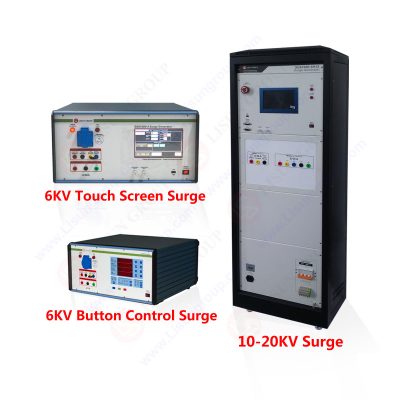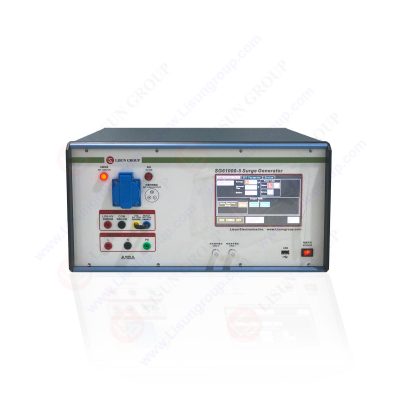Over voltages are a common source of damage in industrial electronic systems. It has been discovered as technology has advanced. Air discharges can also cause over voltages in addition to the equipment’s switching operations. The transfer impedance may be high or low depending on the location of the interference source. The transmission impedance will be low if there is interference in the same circuit as the electronic device.
However, impedance is increased when there is interference from an outside source. Both of these scenarios are modeled using a Combination Wave Generator. It is sometimes referred to as a Surge Generator as well. This paper will primarily concentrate on a surge generator, including its features and benefits.

Surge Generator SG61000-5
Combination wave surges are quick, high voltage and current pulses that occur simultaneously and imitate a variety of EMI problems that occur in the real world, such as lightning strikes and power grid switching.
Tabletop devices with a lot of weight are commonly used as combination wave/surge generators. Planes with links to the ground are necessary. This is to safely use a transient generator in EM test scenarios. Larger coupling/decoupling networks are needed to evaluate three-phase power line systems. This greatly expands the system’s size. The utilization of combination wave/surge generators is essential for meeting performed immunity test standards.
To conduct surge wave testing, you require a surge generator, injection equipment/CDN (if applicable), power supply (if applicable) and unique standard or product requirements (if applicable).
The monitoring equipment includes voltage Differential Probe, current monitoring probe and a capable oscilloscope.
The direct injection approach applies surges directly from the generator to the equipment being tested. This is done without the need of a coupling decoupling network (CDN) or coupling device. Typically, a direct out connection on the front or back of the system is used for this. This connection is only needed for power-off testing.
The most popular way to apply surges to test equipment is by coupling/decoupling networks. This enables equipment to be powered via the CDN going towards the device being tested. Then the pulse is withdrawn after testing without affecting the power supply. These are commonly divided into AC and DC categories as well as levels of voltage and current.
The foregoing characteristics, along with manual and automatic distinctions, serve to distinguish CDNs from one another. A sequence of lines, such as L-N, L-G, etc., are typically evaluated when testing is done regularly. Testing takes longer with manual coupling networks. This is because the physical structure of the cabling must be changed to accommodate the specific lines that need to be tested.
A combined wave generator is basically a very dependable analog lightning surge wave generator made for lighting firms. EMC Surge Immunity Testing is one application for it. Additionally, it can be used to evaluate an electrical circuit’s overvoltage protector. It can also determine the associated electronic components’ impact current absorption capacity and anti-jamming abilities. It provides a precise and excellent foundation for evaluating the immunity to transient overvoltage disturbances of each EUT port. The main benefits of surge wave generators are their intelligence, usability, and dependability.
IEC 61000-4-5’s testing and measuring procedures For the surge immunity test, electromagnetic compatibility (EMC) defines two different types of combination wave generators. Each port type has a different set of applications, depending on the port type to be analyzed. With the 10/700-s combined wave generator, test ports that can connect to outdoor symmetrical communication cables are evaluated. The 1.2/50-s combined wave generator is used in all other situations.

SG61000-5_Surge Generator
This standard’s objective is for output waveforms to satisfy requirements when applied to the EUT. Since waveforms contain open-circuit voltage and short-circuit current, it is necessary to measure them without an EUT. According to LISUN, this generator is built to produce a surge with 1.2 seconds of open-circuit voltage front time, 50 seconds of open-circuit voltage duration, and 8 seconds of short-circuit current front time and 20 seconds of short-circuit current duration.
The ratio of the peak output voltage in open circuit to the peak output current in short circuit at the same output port is known as the combination wave generator’s effective impedance. A 2 effective output impedance is the ratio for this generator. When the generator output is linked to the EUT, the EUT input impedance determines the voltage and current waveform.
This impedance may change during surges to the equipment as a result of installed protection mechanisms functioning properly, or it may flash over or cause component breakage in the absence of or during the inoperative operation of protective devices. The load ought to be able to receive both the 1.2/50s voltage and 8/20s current waves from the same generator output as a consequence.
It is important to consider the safety measures related to the surge wave generators as well. It’s critical to monitor the generator’s heating when it’s running continuously to prevent overheating. Because the DC output port often has a high voltage, there is a risk of electric shocks, hence caution is advised. Additionally, the power fuse needs to be examined for problems in the event of an instrument breakdown or failure. However, if the issues continue, the manufacturer should be contacted for assistance.
It fully complies with GB/T17626.5, EN61000-4-5, and IEC 61000-4-5 standards.
No, the operating principles of the various types of surge generators differ. Due to the fact that surge generators have evolved over time, their operating principles vary. However, how LISUN’s surge generators operate as described above.
Lisun Instruments Limited was found by LISUN GROUP in 2003. LISUN quality system has been strictly certified by ISO9001:2015. As a CIE Membership, LISUN products are designed based on CIE, IEC and other international or national standards. All products passed CE certificate and authenticated by the third party lab.
Our main products are Goniophotometer, Integrating Sphere, Spectroradiometer, Surge Generator, ESD Simulator Guns, EMI Receiver, EMC Test Equipment, Electrical Safety Tester, Environmental Chamber, Temperature Chamber, Climate Chamber, Thermal Chamber, Salt Spray Test, Dust Test Chamber, Waterproof Test, RoHS Test (EDXRF), Glow Wire Test and Needle Flame Test.
Please feel free to contact us if you need any support.
Tech Dep: Service@Lisungroup.com, Cell/WhatsApp:+8615317907381
Sales Dep: Sales@Lisungroup.com, Cell/WhatsApp:+8618117273997
Your email address will not be published. Required fields are marked *